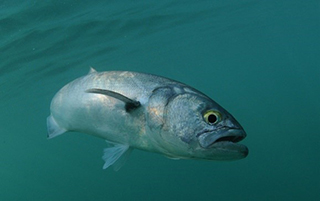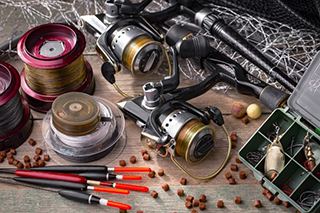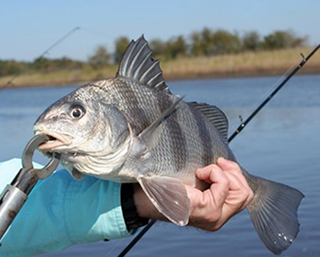Surfcasting
Cape Cod Surfcasting: When How and Where

Surfcasting is an exciting way to experience saltwater fishing without having to get on a boat, and Cape Cod offers some of the best surfcasting around. Whether you want to relax next to your pole on a sandy beach, get out on a pier, traverse rocky banks, or wade out with the receding tide, surfcasting is a brand of fishing that has something for everyone.
Cape Cod and the Islands offer an incredible variety of marine habitat. The  currents, underwater landscape, tides, and waterways provide plenty of natural bait attracting an array of sport fish. Bluefish, Red Drum, Spanish Mackerel and Kingfish put up a good fight. Striped Bass, Flounder and Sharks are an excellent meal and desirable trophies. Croaker, Scup and Pompano are bountiful, and you’ll also come across Weakfish, Speckled Trout, Skates and Rays in your surfcasting adventures around the Cape.
currents, underwater landscape, tides, and waterways provide plenty of natural bait attracting an array of sport fish. Bluefish, Red Drum, Spanish Mackerel and Kingfish put up a good fight. Striped Bass, Flounder and Sharks are an excellent meal and desirable trophies. Croaker, Scup and Pompano are bountiful, and you’ll also come across Weakfish, Speckled Trout, Skates and Rays in your surfcasting adventures around the Cape.
To choose a fishing spot, look for structure, bait sources, and currents. Fish like to hide and will hang out where there are rocks, troughs between sandbars, jetties, and piers. Anywhere fish come to feed is a good place to start. The mouths of rivers and streams deliver bait and keep the fish coming back for more. Currents move food (and your bait) through fish hunting grounds, so it’s important to know which way the water is moving. As for when to plan your surfcasting excursion, just be prepared. Different baits and lures work better day or night. The wind will determine whether lightweight tackle is an option or heavy lures, and weighted rigs are a necessity. And knowing when the tide will rise or roll out will make it much easier to plan for a successful day (or night) of fishing.
 Next, you’ll need a rod and reel. Longer rods increase casting distance but can be hard to control. A nine-foot medium to heavy pole with relatively fast action meets many anglers’ needs. Each rod is designed for a conventional or spinning reel. Conventional baitcasting reels can work for surfcasting but are a challenge to cast. Spinning reels are easier to operate, and a necessity for using lures. The best line depends how far you need to cast, how heavy your lures or rigs are, how big the fish you’re after are, the wind, and what the rod is designed for – generally 15-30 pound, and braided line lasts longer.
Next, you’ll need a rod and reel. Longer rods increase casting distance but can be hard to control. A nine-foot medium to heavy pole with relatively fast action meets many anglers’ needs. Each rod is designed for a conventional or spinning reel. Conventional baitcasting reels can work for surfcasting but are a challenge to cast. Spinning reels are easier to operate, and a necessity for using lures. The best line depends how far you need to cast, how heavy your lures or rigs are, how big the fish you’re after are, the wind, and what the rod is designed for – generally 15-30 pound, and braided line lasts longer.
For bait fishing, popular rigs include the fish-finder, which allows the bait to move while the weight is stationary, flounder, high-low, triple-swivel or two-hook bottom rigs with a weight at the end and hooks suspended along the line above it, or a single or double hook fireball that uses floats to lift the bait hooks off the bottom. Bait shops often carry pre-assembled rigs if you’re not sure about setting them up yourself.
Hooks, weights, and baits are important choices, too. Circle hooks reduce the likelihood of gut-hooking and are mandatory in some cases. Straight shanks instead of bent eyelets may lead to fewer tangles. For tentative fish, J hooks work better, but they’re bad for catch-and-release. The best sinker depends on the rig, how rocky the bottom is, and the wind. For sandy bottoms, use something that will stick, like a pyramid, storm, or grapple sinker. If there are rocks, disk, egg, and casting sinkers lead to fewer snags. The best bait is what the fish are eating.
 Crabs, eels, and squid work well around Cape Cod. Shrimp, blood worm, and cut fish can also be good, depending on the fish you are after. Artificial baits that simulate the fishes’ natural targets can be a useful alternative, sometimes working even better than the real thing.
Crabs, eels, and squid work well around Cape Cod. Shrimp, blood worm, and cut fish can also be good, depending on the fish you are after. Artificial baits that simulate the fishes’ natural targets can be a useful alternative, sometimes working even better than the real thing.
If you’d rather use lures, popular choices include swimming and top water plugs. Heavy metal spoons are a classic option and can sometimes be just what it takes to get the fish going. Lead headed jigs are infinitely versatile for use with real or artificial bait. A bit of bucktail can also go a long way to triggering some action whether it’s added to a spoon, lure, or jig.
While the choices, options, and variables that go into setting up a Cape Cod surfcasting experience may seem a little overwhelming, hopefully this introduction gives you enough to get started. Remember, it doesn’t have to be perfect because any day fishing is still better than a day spent doing just about anything else.


